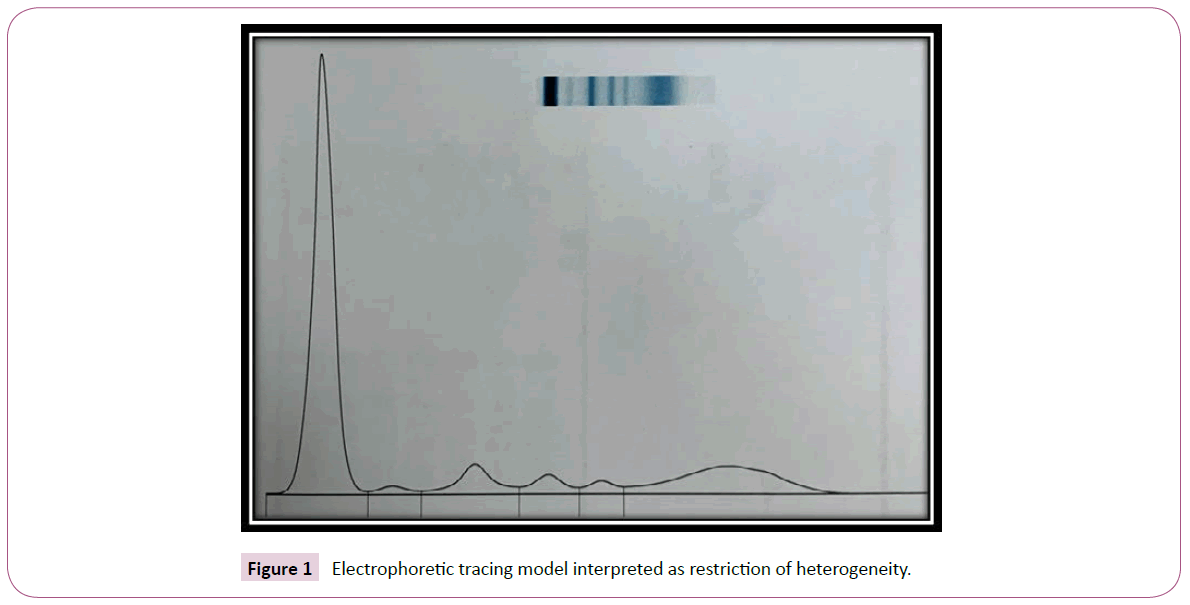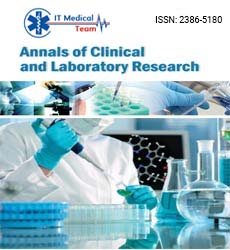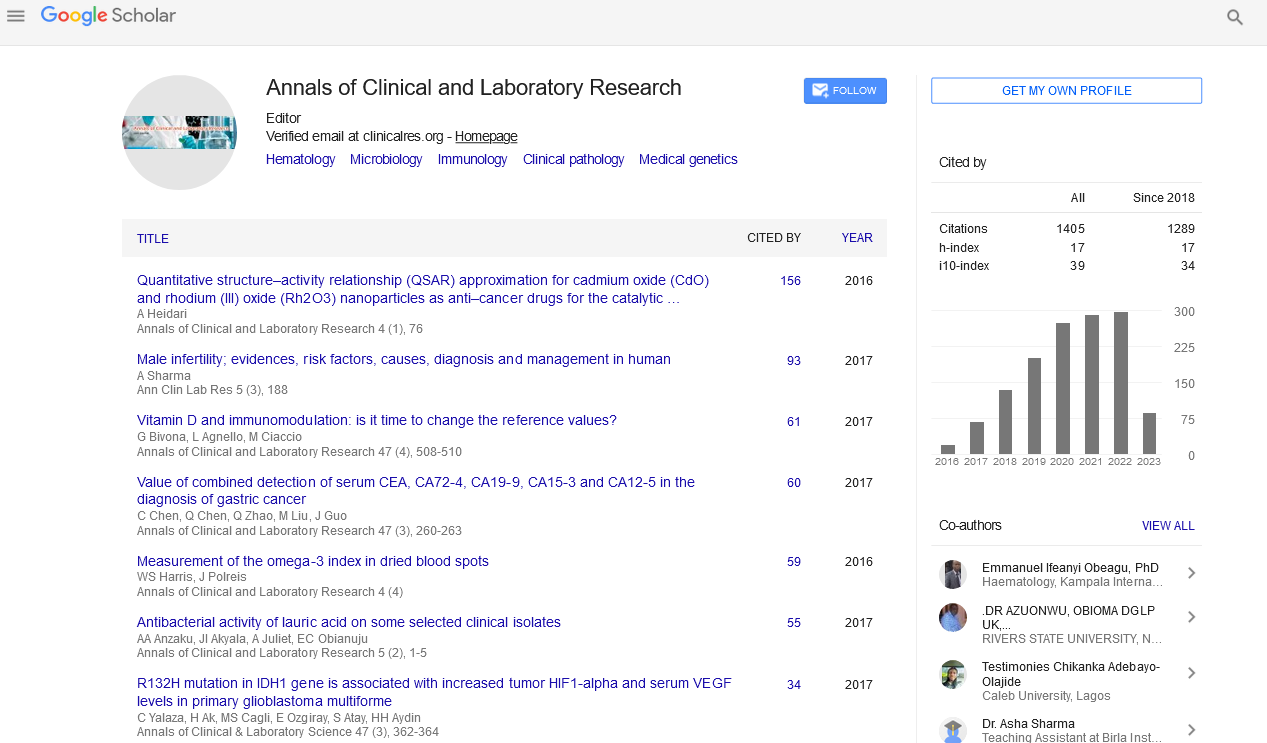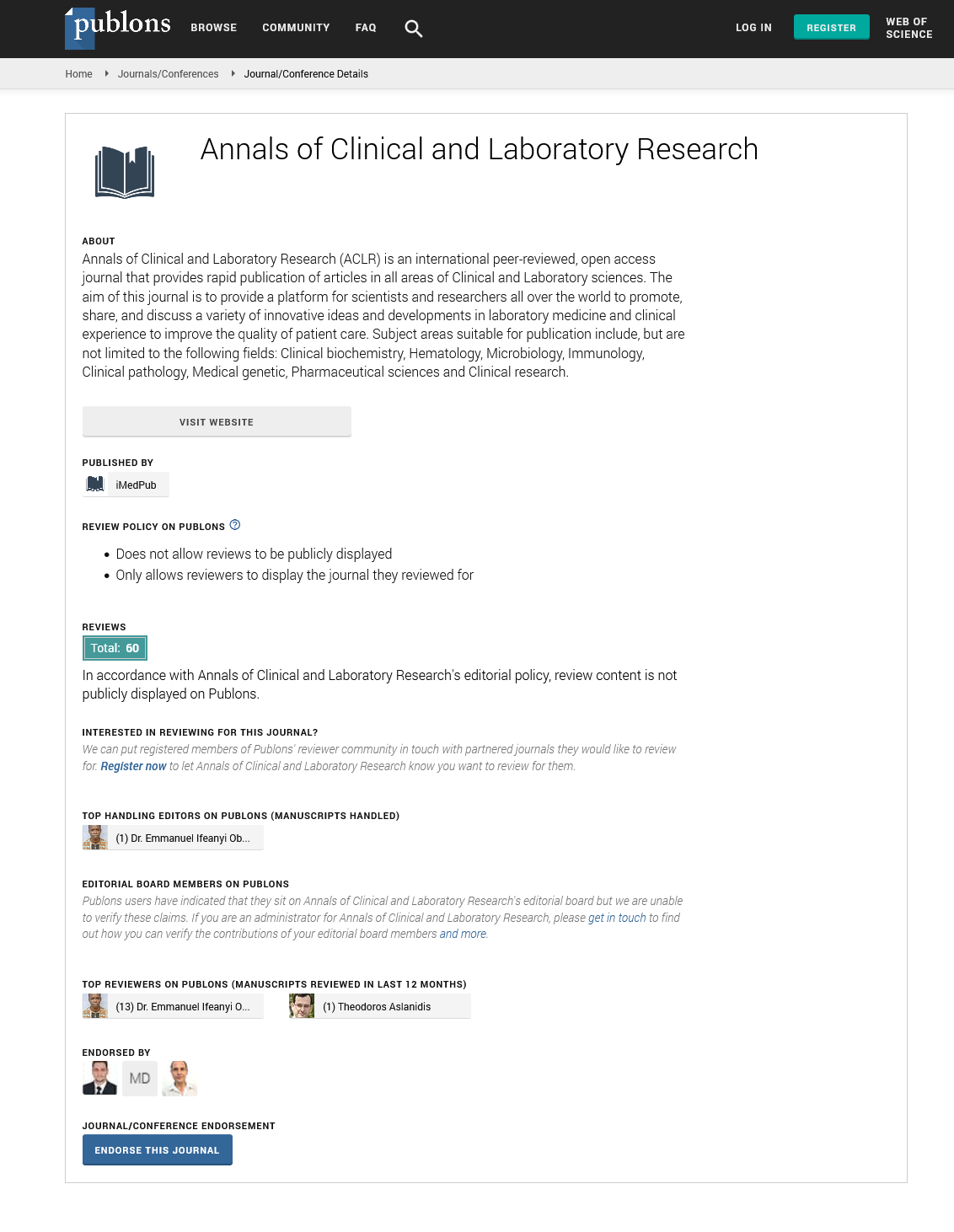Short Communication - (2022) Volume 10, Issue 6
Pertinence of the Immunofixation Prescription in Heterogeneity Restrictions of the Gammaglobulin Zone
Soufiane Nader1*,
Adam Bentahila1,
Mehdi Ztoute1,
Abdelhamid Zrara2 and
Amina Benouda1
1Department of Laboratory Medicine, Medical laboratory of Cheikh Zaid hospital, Abulcasis International University of Health Sciences, Morocco
2Department of Laboratory Medicine, Mohamed V military training hospital, Abulcasis International University of Health Sciences, Morocco
*Correspondence:
Soufiane Nader, Department of Laboratory Medicine, Medical laboratory of Cheikh Zaid hospital, Abulcasis International University of Health Sciences,
Morocco,
Email:
Received: 27-Apr-2022, Manuscript No. IPACLR-22-12756;
Editor assigned: 29-Apr-2022, Pre QC No. IPACLR-22-12756(PQ);
Reviewed: 13-May-2022, QC No. IPACLR-22-12756;
Revised: 03-Jun-2022, Manuscript No. IPACLR-22-12756(R);
, DOI: 10.36648/2386-5180.22.10.415
Abstract
Monoclonal gammopathies are regularly materialized on an EPP by a narrow peak in the gamma zone. Sometimes this expression is expressed by a deformation which affects the Gaussian aspect of the curve expressing these gamma globulins it is called restriction of the heterogeneity of the gamma globulins, this can mask a monoclonal gammopathy. Our objective is to study the relevance of prescribing immunofixation in this circumstance. This is a retrospective study of all serum protein electrophoresis completed by immunofixation. 16 patients had restriction of gammaglobulin heterogeneity. Immunofixation revealed that 12 cases (75%) out of 16 had indeed monoclonal gammopathy. It can thus be concluded that the restrictions of gamma heterogeneity in elderly patients should raise the suspicion of monoclonal gammopathies.
Keywords
Immunofixation prescription, Heterogeneity restrictions, Serum
protein electrophoresis
Introduction
Monoclonal gammopathy is defined by the presence of a
monoclonal peak evolving in the gamma globulin zone during
migration by Serum Protein Electrophoresis (SPE), it is coupled
with a precipitation technique: Immunofixation (IF) which allows
him, by the use of monoclonal antibodies, to identify the fraction
concerned. This migration of the monoclonal peak can also occur in
the beta-globulin zone or, more rarely, by hypogammaglobulinemia
or else a restriction of heterogeneity in the gamma zone.
The Restriction of Heterogeneity (RH) is defined by the working
group of the National College of Hospital Biochemistry (NCBH)
which adapts to the evolution of capillary electrophoresis by:
"The non-respect of the shape of the curve encompassing all
of the gamma globulins, with loss of its symmetry without this
obligatory presence of the narrow peak, the integration curve
presents several points of inflection” [1-3].
RH physiological meaning is the decrease in the diversity of
immunoglobulin synthesis, and proliferation to a lesser extent
of one or more plasma cell clones. Because of this physiological
process, RH can have multiple origins, be transient or longlasting
[4,5]. On a practical level, faced with a restriction of
heterogeneity, the question arises whether or not to supplement
with immunofixation or simply to monitor.
The objective of this work is to attempt to answer this question
by studying the percentage of monoclonal gammopathies in
patients presenting with an HR gamma zone at the SPE of the
Cheikh Zaid hospital in Rabat.
Materials and Methods
The study was conducted at the medical biology laboratory
of Cheikh Zaid university hospital Rabat at the immunology
department. It is a retrospective study spread over a period of 18
months (between January 2017 and June 2018), referring to the
records of serum protein electrophoresis and immunofixations.
We included in this study, all heterogeneity restrictions completed
by immunofixation. Heterogeneity restrictions in patients
followed for monoclonal gammopathy, transplant patients, and
in those with clinical and biological presentation of an infectious
syndrome or autoimmune disease were not included in this study. Serum protein electrophoresis and immunofixation were
performed on agarose gel (HYDRASYS 2scan SEBIA* and
HYDRASYS 2scan SEBIA*IF). 1270 serum protein electrophoreses
were performed over this 1.5-year period, of which 70 were
completed by immunofixation. Out of the 70 immunofixations,
16 of them had heterogeneity restriction in the gamma globulin
area (Table 1). The diagnosis of biclonal MGUS was retained with
strict short-term monitoring.
| Results of serum protein electrophoresis |
Numbers (%) |
| Monoclonal peak in gamma globulin |
48(68%) |
| Heterogeneity restriction of gamma globulins |
16(23%) |
| Hypogammaglobulinemia |
03(4,5%) |
| Others (Alpha or Beta globulin anomaly) |
03(4,5%) |
| Total |
70(100%) |
Table 1: Results of electrophoresis completed by immunofixation.
Results
Our study population consists of 16 patients. It corresponds to
all those who presented a restriction of heterogeneity to the
EPP supplemented by an immunofixation. 12 out of 16 cases
presented monoclonal gammopathies and 2 out of 16 cases were
bi-clonal gammopathies distributed as follows:
• 7 cases of IgG-Kappa
• 4 cases of IgG-Lambda
• 1 case of IgA-Lambda
• 1 case of 'IgG-Kappa + IgA-Kappa and
• 1 case of IgG-Kappa + IgG-Lambda
• 2 of the 16 cases were normal.
The average age of patients with monoclonal gammopathy was
71 years with an average age of 56 to 89 years. The average age of
patients with normal immunofixation was 43 years with a range
of 41 to 45 years. 7 of our patients with monoclonal gammopathy
were men while 5 of them were women. The two cases with
normal immunofixation were female.
Discussion
Immunofixation revealed that 12 of 16 cases (75%) of
heterogeneity restrictions had monoclonal gammopathy. During
this period, the interpretation of the SPE was carried out by the
same biologist according to the aspect of the curve of gamma
globulins (Figure 1).

Figure 1. Electrophoretic tracing model interpreted as restriction of heterogeneity.
The Haute Autorite de Sante de France (HAS) in its
recommendations also advises against systematically performing
an IF in cases of RH [6,7], which finds some uncertainty in this
recommendation. By the results of our study showing that it was
relevant to complete HR with immunofixation even if our study
does not include patients with benign diseases. The technique
used in our study is agarose gel electrophoresis, which is less
sensitive than capillary electrophoresis and therefore detects less
RH. This would help explain this discrepancy.
In an article on this subject, it was mentioned that the nondeclaration
of this anomaly could be responsible for a delay in
the diagnosis of AL amyloidosis, lymphoma or oligo-secretory
myeloma [5,6]. An approach recommended by Keren [5] states
that when faced with such a finding, either advice Bence Jones
protein performance or include a comment that repeat testing/
follow-up could be considered within a clinically appropriate, e.g.
3-6 months.
The average age of patients with monoclonal gammopathy was
71 years. This has also been reported in other studies. The two patients who did not have monoclonal gammopathies were young
(41 and 45 years old), which is consistent with the literature. The
immunology laboratory of the Sud Lyon hospital group (Hospices
Civils de Lyon) offers a scheme for interpreting and monitoring
heterogeneity restrictions according to the patient's age and
clinical and biological context, which excludes young patients any
further exploration [7].
Conclusion
Our study shows that the profiles of heterogeneity restrictions
in PPE in elderly patients without benign pathologies are
monoclonal gammopathies until proven otherwise. It is therefore
appropriate to underline the importance of clinician and biologist
collaboration in the establishment of the indication as well as the
interpretation and follow-up of borderline cases.
REFERENCES
- Rochat J, Kolopp-Sarda MN, Dechomet M, Lombard C (2021) Restriction of gamma globulin heterogeneity on serum protein electrophoresis. Revue Francophone des Laboratoires. 531: 48-57.
Cross Ref
- Decauxa O, Rodon P, Ruelland A, Estepa L, Leblaya R, et al. (2007) Epidemiology of monoclonal gammopathy in a general Hospital and a University Internal Medicine Department. Rev Med Interne. 28: 670-676.
Indexed at, Google Scholar, Cross Ref
- Szymanowicz A, Cartier B, Couaillac J, Gibaud C, Poulin G, et al. (2006) Proposition de commentaires interprétatifs prêts à l’emploi pour l’électrophorèse des protéines sériques. Annales De Biologie Clinique. 64: 367-380.
Indexed at, Google Scholar
- Tate J, Caldwell G, Daly J, Gillis D, Jenkins M, et al. (2012) Recommendations for standardized reporting of protein electrophoresis in Australia and New Zealand. Ann Clin Biochem. 49: 242-256.
Indexed at, Google Scholar, Cross Ref
- Keren Df (1999) Procedures for the evaluation of monoclonal immunoglobulins. Arch Pathol Lab Med. 123: 126-132.
Google Scholar, Cross Ref
- Merlini G, Stone MJ (2006) Dangerous small B-cell clones. Blood. 108:2520-2530.
Indexed at, Google Scholar, Cross Ref
- Recommendation of Good Practice (2007) When to prescribe serum protein electrophoresis (SPE) and what to do in case of monoclonal immunoglobulin. Haute Autorité de Santé.
Citation: Nader S, Bentahila A, Ztoute M, Zrara A, Benouda A (2022) Pertinence of the Immunofixation Prescription in Heterogeneity Restrictions of the
Gammaglobulin Zone. Ann Clin Lab Res. Vol.10 No.6:415







